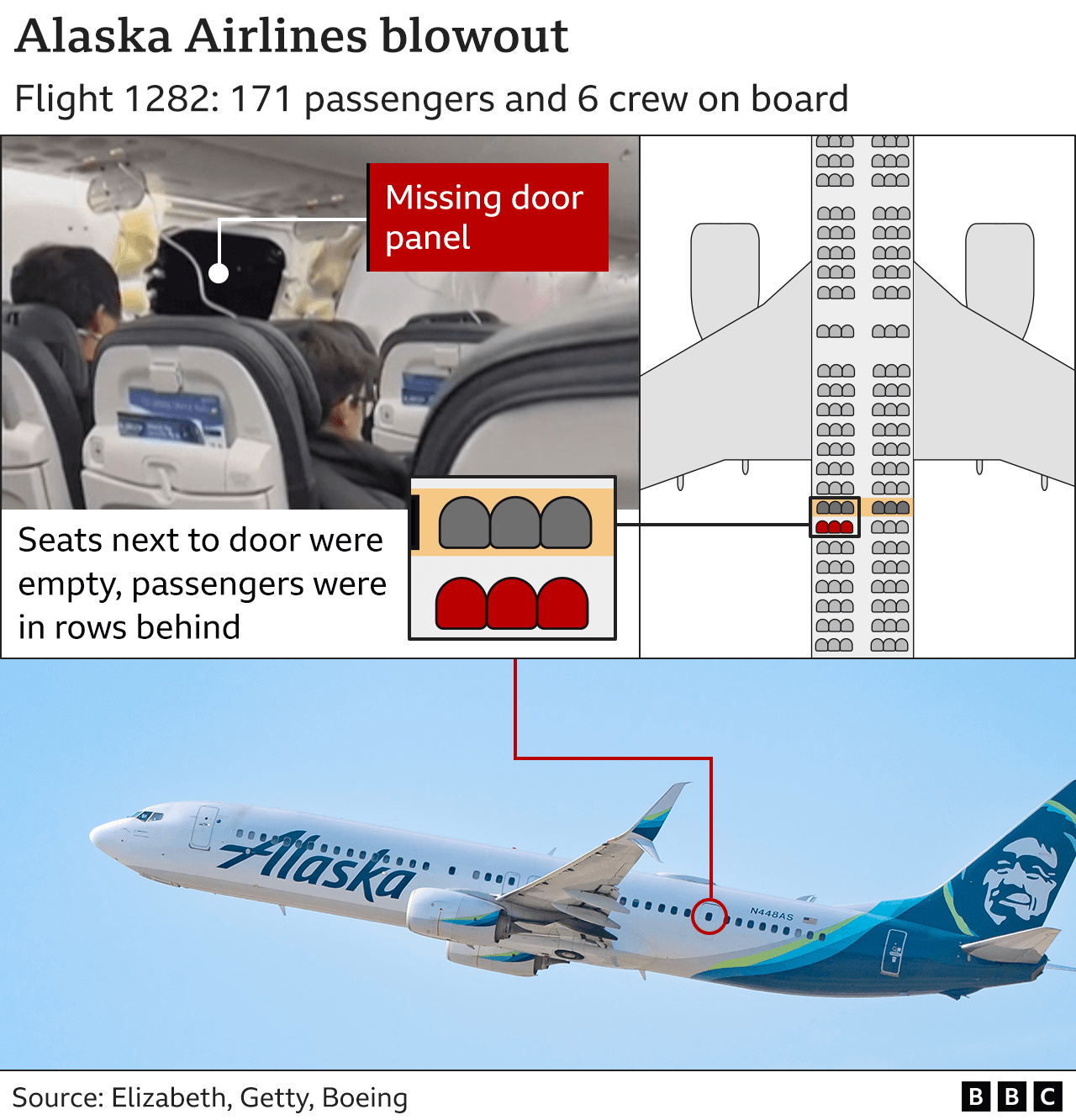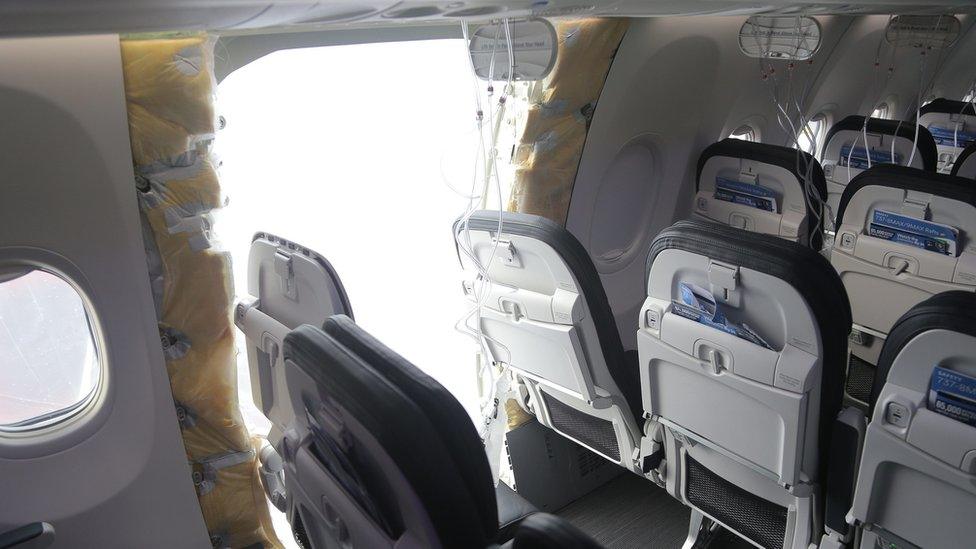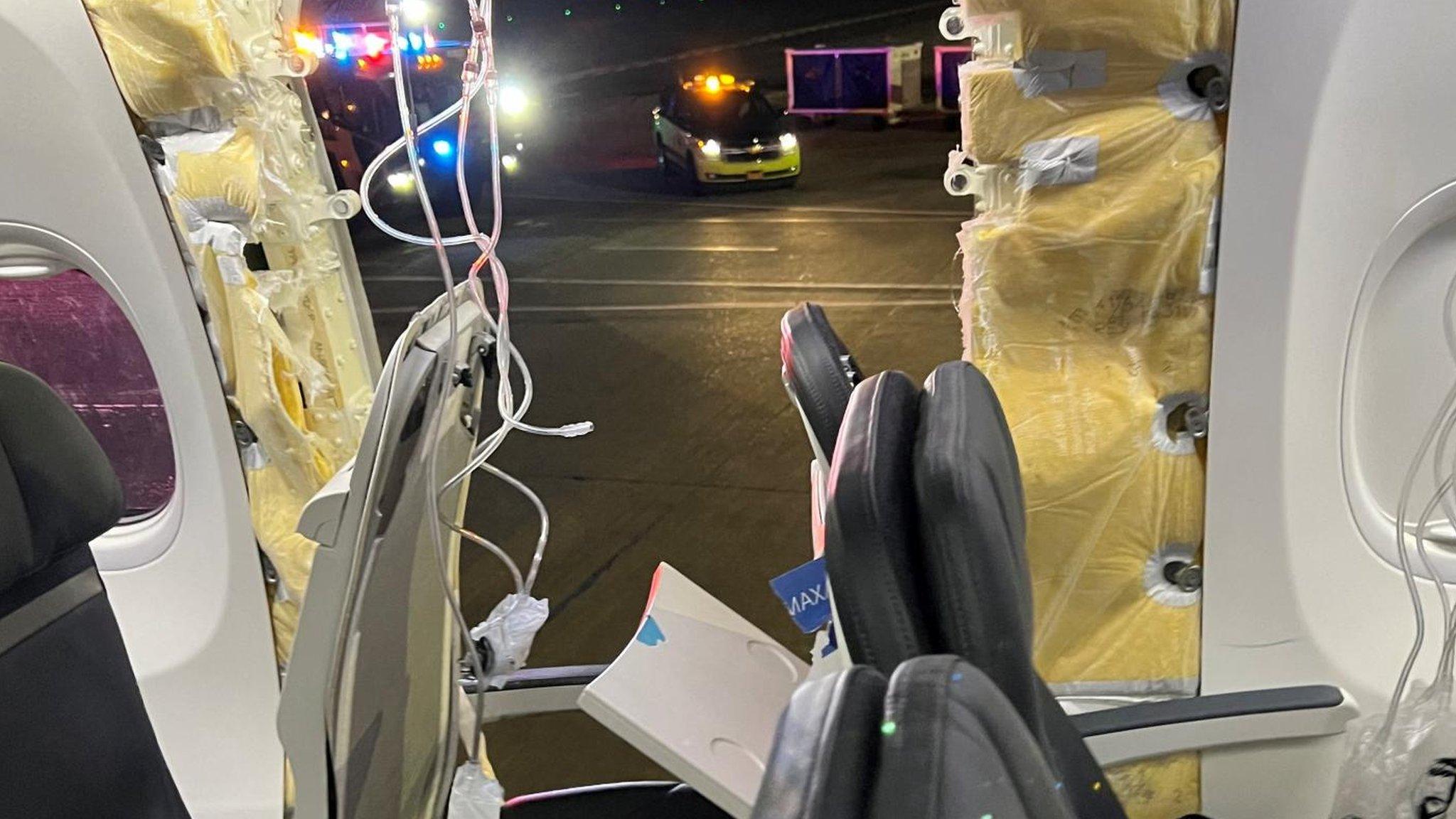Alaskan Airlines flight 1282: Key questions behind door plug blowout
- Published
Watch: 'Trip from hell': On board flight during mid-air blowout
Alaska Airlines flight 1282 was on a routine flight from Portland in Oregon to Ontario in California, when an unused cabin door broke away a few minutes after take off.
The section that fell from the sky was a 27kg (60lb) part of the shell. Known as a door plug, this was used to fill an emergency exit that was built into the plane but not needed by Alaska Airlines.
The cabin abruptly depressurised, creating a rush of air that ripped off the flight crews headsets and sent phones and other items flying out of the plane.
Why did a brand-new aircraft experience such a dramatic technical failure?
The aircraft was delivered to Alaska Airlines on 31 October 2023, and would only have completed around 100 flights a month. Normal wear and tear or maintenance failures are unlikely to have been factors affecting such a young aircraft.
The National Transportation Safety Board (NTSF), which is investigating the accident, has already said it does not suspect a design flaw. In fact, this type of door has been used on older Boeing 737s since 2006, and has not suffered any serious issues.
That means the focus is likely to be on whether the door itself could have been faulty, and whether it was bolted in place correctly.
Alaska Airlines says it has since inspected other planes of the same type - Boeing 737 Max 9s - and discovered "some loose hardware".
Meanwhile, United Airlines says bolts in need of "additional tightening" have been found while inspecting the relevant parts of its own fleet of 737 Max 9s.

The door was produced by Boeing's supplier Spirit AeroSystems, which has previously faced criticism for serious quality control failures.
But Boeing itself has been accused in the past of chaotic conditions in its factories and corners being cut on the production line.
Boeing insists that is not the case today, and emphasises that safety is its first priority. The discovery of the missing door will provide vital clues for investigators about what went wrong and why.
Why did the aircraft have an unused door?
The 737 Max 9 has been ordered by many different airlines. The way they use those planes will not always be the same, and there are different options available for seating.
The number of emergency exits required depends on the number of seats. With a less crowded cabin, it can operate with four main doors, and another four smaller exits over the wings.
But if configured with the maximum number of seats, a further two exits are required - midway between the wings and the tail of the aircraft.
In practice, Boeing builds all its Max 9 airframes with these extra doors. If they are not required, a non-operational door, or "plug" is fitted, concealed behind the interior trim.

Why did Alaska Airlines allow the plane to fly after cabin pressure warnings?
The light that came on in the cockpit is known as an "auto pressurisation fail" light. It comes on when the pressure in the cabin, which is usually regulated automatically, changes at an unusually fast rate. The crew can respond by adjusting the cabin pressure manually, or if concerned by descending to a lower altitude.
However, such warnings can also appear due to minor faults. In the case of the Alaska Airlines plane, the light had come on during several flights over a short period.
The issue had clearly been reported to maintenance staff, whose response would have been dictated by the aircraft's maintenance manual.
This is a document written by Boeing, but signed off by regulators. Restrictions were placed on where the plane could fly, and according to the NTSB additional investigations had been ordered, but had yet to be carried out when the failure occurred.

Why did Alaska Airlines briefly allow some aircraft to resume flying?
In the immediate aftermath of Friday's accident (this is the term used by the NTSB), Alaska Airlines grounded its entire fleet of 65 737 Max 9 aircraft.
However, on Saturday 18 planes were briefly allowed back into service. Those planes had recently undergone major overhauls, including inspections of door plugs. No problems had been found and the company believed they were safe.
But when the Federal Aviation Administration issued an airworthiness directive banning affected aircraft from flying until they had undergone specific checks, it had no option but to ground all 18 planes once again.
What are the next steps?
The NTSB is carrying out a full investigation. This will involve, for example, examining the plane itself, the lost door (which has now been found in a back garden in Oregon), the contents of the flight data recorder and maintenance records, as well as interviewing flight crew, maintenance staff and employees of Boeing and Spirit AeroSystems.
The purpose of the investigation is to find out what went wrong and why. It is not meant to apportion blame.
However, there is clear jeopardy here for Boeing. The 737 Max is its bestselling aircraft, a favourite among airlines because of its low running costs and fuel efficiency.
But its safety record has already been badly tarnished as a result of two accidents that occurred in late 2018 and early 2019, in which 346 people were killed.
The aerospace giant insists it is a different company today. In a message to staff, chief executive Dave Calhoun said "when serious accidents like this occur, it is critical for us to work transparently with our customers and regulators to understand and address the causes of the event, and to ensure they don't happen again."

Related topics
- Published8 January 2024

- Published8 January 2024

- Published7 January 2024

- Published7 January 2024
